After studying this Unit, you will be able to
• explain the terms : system and surroundings;
• discriminate between close, open and isolated systems;
• explain internal energy, work and heat;
• state first law of thermodynamics and express it mathematically;
• calculate energy changes as work and heat contributions in chemical systems;
• explain state functions: U, H.
• correlate ∆U and ∆H;
• measure experimentally ∆U and ∆H;
• define standard states for ∆H;
• calculate enthalpy changes for various types of reactions;
• state and apply Hess’s law of constant heat summation;
• differentiate between extensive and intensive properties;
• define spontaneous and non-spontaneous processes;
• explain entropy as a thermodynamic state function and apply it for spontaneity;
• explain Gibbs energy change (∆G); and
• establish relationship between ∆G and spontaneity, ∆G and equilibrium constant.
It is the only physical theory of universal content concerning which I am convinced that, within the framework of the applicability of its basic concepts, it will never be overthrown.
Albert Einstein
Chemical energy stored by molecules can be released as heat during chemical reactions when a fuel like methane, cooking gas or coal burns in air. The chemical energy may also be used to do mechanical work when a fuel burns in an engine or to provide electrical energy through a galvanic cell like dry cell. Thus, various forms of energy are interrelated and under certain conditions, these may be transformed from one form into another. The study of these energy transformations forms the subject matter of thermodynamics. The laws of thermodynamics deal with energy changes of macroscopic systems involving a large number of molecules rather than microscopic systems containing a few molecules. Thermodynamics is not concerned about how and at what rate these energy transformations are carried out, but is based on initial and final states of a system undergoing the change. Laws of thermodynamics apply only when a system is in equilibrium or moves from one equilibrium state to another equilibrium state. Macroscopic properties like pressure and temperature do not change with time for a system in equilibrium state. In this unit, we would like to answer some of the important questions through thermodynamics, like:
How do we determine the energy changes involved in a chemical reaction/process? Will it occur or not?
What drives a chemical reaction/process?
To what extent do the chemical reactions proceed?
We are interested in chemical reactions and the energy changes accompanying them. For this we need to know certain thermodynamic terms. These are discussed below.
6.1.1 The System and the Surroundings
A system in thermodynamics refers to that part of universe in which observations are made and remaining universe constitutes the surroundings. The surroundings include everything other than the system. System and the surroundings together constitute the universe .
The universe = The system + The surroundings
However, the entire universe other than the system is not affected by the changes taking place in the system. Therefore, for all practical purposes, the surroundings are that portion of the remaining universe which can interact with the system. Usually, the region of space in the neighbourhood of the system constitutes its surroundings.
For example, if we are studying the reaction between two substances A and B kept in a beaker, the beaker containing the reaction mixture is the system and the room where the beaker is kept is the surroundings (Fig. 6.1).

Fig. 6.1 System and the surroundings
Note that the system may be defined by physical boundaries, like beaker or test tube, or the system may simply be defined by a set of Cartesian coordinates specifying a particular volume in space. It is necessary to think of the system as separated from the surroundings by some sort of wall which may be real or imaginary. The wall that separates the system from the surroundings is called boundary. This is designed to allow us to control and keep track of all movements of matter and energy in or out of the system.
6.1.2 Types of the System
We, further classify the systems according to the movements of matter and energy in or out of the system.
1. Open System
In an open system, there is exchange of energy and matter between system and surroundings [Fig. 6.2 (a)]. The presence of reactants in an open beaker is an example of an open system*. Here the boundary is an imaginary surface enclosing the beaker and reactants.
2. Closed System
In a closed system, there is no exchange of matter, but exchange of energy is possible between system and the surroundings
[Fig. 6.2 (b)]. The presence of reactants in a closed vessel made of conducting material e.g., copper or steel is an example of a closed system.

Fig. 6.2 Open, closed and isolated systems.
* We could have chosen only the reactants as system then walls of the beakers will act as boundary.
3. Isolated System
In an isolated system, there is no exchange of energy or matter between the system and the surroundings [Fig. 6.2 (c)]. The presence of reactants in a thermos flask or any other closed insulated vessel is an example of an isolated system.
6.1.3 The State of the System
The system must be described in order to make any useful calculations by specifying quantitatively each of the properties such as its pressure (p), volume (V), and temperature (T ) as well as the composition of the system. We need to describe the system by specifying it before and after the change. You would recall from your Physics course that the state of a system in mechanics is completely specified at a given instant of time, by the position and velocity of each mass point of the system. In thermodynamics, a different and much simpler concept of the state of a system is introduced. It does not need detailed knowledge of motion of each particle because, we deal with average measurable properties of the system. We specify the state of the system by state functions or state variables.
The state of a thermodynamic system is described by its measurable or macroscopic (bulk) properties. We can describe the state of a gas by quoting its pressure (p), volume (V), temperature (T ), amount (n) etc. Variables like p, V, T are called state variables or state functions because their values depend only on the state of the system and not on how it is reached. In order to completely define the state of a system it is not necessary to define all the properties of the system; as only a certain number of properties can be varied independently. This number depends on the nature of the system. Once these minimum number of macroscopic properties are fixed, others automatically have definite values.
The state of the surroundings can never be completely specified; fortunately it is not necessary to do so.
6.1.4 The Internal Energy as a State Function
When we talk about our chemical system losing or gaining energy, we need to introduce a quantity which represents the total energy of the system. It may be chemical, electrical, mechanical or any other type of energy you may think of, the sum of all these is the energy of the system. In thermodynamics, we call it the internal energy, U of the system, which may change, when
• heat passes into or out of the system,
• work is done on or by the system,
• matter enters or leaves the system.
These systems are classified accordingly as you have already studied in section 6.1.2.
(a) Work
Let us first examine a change in internal energy by doing work. We take a system containing some quantity of water in a thermos flask or in an insulated beaker. This would not allow exchange of heat between the system and surroundings through its boundary and we call this type of system as adiabatic. The manner in which the state of such a system may be changed will be called adiabatic process. Adiabatic process is a process in which there is no transfer of heat between the system and surroundings. Here, the wall separating the system and the surroundings is called the adiabatic wall (Fig 6.3).
Let us bring the change in the internal energy of the system by doing some work on it. Let us call the initial state of the system as state A and its temperature as TA. Let the internal energy of the system in state A be called UA. We can change the state of the system in two different ways.
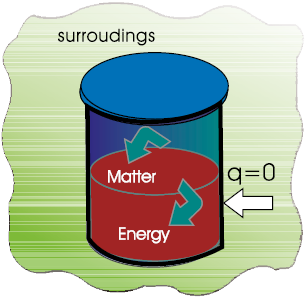
One way: We do some mechanical work, say 1 kJ, by rotating a set of small paddles and thereby churning water. Let the new state be called B state and its temperature, as TB. It is found that TB > TA and the change in temperature, ∆T = TB–TA. Let the internal energy of the system in state B be UB and the change in internal energy, ∆U =UB– UA.
We now do an equal amount (i.e., 1kJ) electrical work with the help of an immersion rod and note down the temperature change. We find that the change in temperature is same as in the earlier case, say, TB – TA.
In fact, the experiments in the above manner were done by J. P. Joule between 1840–50 and he was able to show that a given amount of work done on the system, no matter how it was done (irrespective of path) produced the same change of state, as measured by the change in the temperature of the system.
So, it seems appropriate to define a quantity, the internal energy U, whose value is characteristic of the state of a system, whereby the adiabatic work, wad required to bring about a change of state is equal to the difference between the value of U in one state and that in another state, ∆U i.e.,

Therefore, internal energy, U, of the system is a state function.
By conventions of IUPAC in chemical thermodynamics. The positive sign expresses that wad is positive when work is done on the system and the internal energy of system increases. Similarly, if the work is done by the system,wad will be negative because internal energy of the system decreases.
Can you name some other familiar state functions? Some of other familiar state functions are V, p, and T. For example, if we bring a change in temperature of the system from 25°C to 35°C, the change in temperature is 35°C–25°C = +10°C, whether we go straight up to 35°C or we cool the system for a few degrees, then take the system to the final temperature. Thus, T is a state function and the change in temperature is independent of the route taken. Volume of water in a pond, for example, is a state function, because change in volume of its water is independent of the route by which water is filled in the pond, either by rain or by tubewell or by both.
(b) Heat
We can also change the internal energy of a system by transfer of heat from the surroundings to the system or vice-versa without expenditure of work. This exchange of energy, which is a result of temperature difference is called heat, q. Let us consider bringing about the same change in temperature (the same initial and final states as before in section 6.1.4 (a) by transfer of heat through thermally conducting walls instead of adiabatic walls (Fig. 6.4).
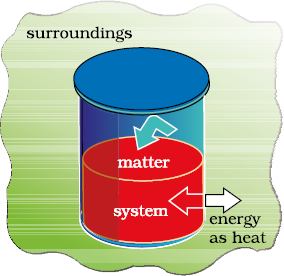
We take water at temperature, TA in a container having thermally conducting walls, say made up of copper and enclose it in a huge heat reservoir at temperature, TB. The heat absorbed by the system (water), q can be measured in terms of temperature difference , TB – TA. In this case change in internal energy, ∆U= q, when no work is done at constant volume.
By conventions of IUPAC in chemical thermodynamics. The q is positive, when heat is transferred from the surroundings to the system and the internal energy of the system increases and q is negative when heat is transferred from system to the surroundings resulting in decrease of the internal energy of the system..
* Earlier negative sign was assigned when the work is done on the system and positive sign when the work is done by the system. This is still followed in physics books, although IUPAC has recommended the use of new sign convention.
(c) The general case
Let us consider the general case in which a change of state is brought about both by doing work and by transfer of heat. We write change in internal energy for this case as:
∆U = q + w (6.1)
For a given change in state, q and w can vary depending on how the change is carried out. However, q +w = ∆U will depend only on initial and final state. It will be independent of the way the change is carried out. If there is no transfer of energy as heat or as work (isolated system) i.e., if w = 0 and q = 0, then
∆ U = 0.
The equation 6.1 i.e., ∆U = q + w is mathematical statement of the first law of thermodynamics, which states that
The energy of an isolated system is constant.
It is commonly stated as the law of conservation of energy i.e., energy can neither be created nor be destroyed.
Note: There is considerable difference between the character of the thermodynamic property energy and that of a mechanical property such as volume. We can specify an unambiguous (absolute) value for volume of a system in a particular state, but not the absolute value of the internal energy. However, we can measure only the changes in the internal energy, ∆U of the system.
Problem 6.1
Express the change in internal energy of a system when
(i) No heat is absorbed by the system from the surroundings, but work (w) is done on the system. What type of wall does the system have ?
(ii) No work is done on the system, but q amount of heat is taken out from the system and given to the surroundings. What type of wall does the system have?
(iii) w amount of work is done by the system and q amount of heat is supplied to the system. What type of system would it be?
Solution
(i) ∆ U = w ad, wall is adiabatic
(ii) ∆ U = – q, thermally conducting walls
(iii) ∆ U = q – w, closed system.
Many chemical reactions involve the generation of gases capable of doing mechanical work or the generation of heat. It is important for us to quantify these changes and relate them to the changes in the internal energy. Let us see how!
6.2.1 Work
First of all, let us concentrate on the nature of work a system can do. We will consider only mechanical work i.e., pressure-volume work.
For understanding pressure-volume work, let us consider a cylinder which contains one mole of an ideal gas fitted with a frictionless piston. Total volume of the gas is Vi and pressure of the gas inside is p. If external pressure is pex which is greater than p, piston is moved inward till the pressure inside becomes equal to pex. Let this change be achieved in a single step and the final volume be Vf . During this compression, suppose piston moves a distance, l and is cross-sectional area of the piston is A
[Fig. 6.5(a)].

Fig. 6.5(a) Work done on an ideal gas in a cylinder when it is compressed by a constant external pressure, pex
(in single step) is equal to the shaded area.
then, volume change = l × A = ∆V = (Vf – Vi )
We also know, 
Therefore, force on the piston = pex . A
If w is the work done on the system by movement of the piston then
w = force × distance = pex . A .l
= pex . (–∆V) = – pex ∆V = – pex (Vf – Vi ) (6.2)
The negative sign of this expression is required to obtain conventional sign for w, which will be positive. It indicates that in case of compression work is done on the system. Here (Vf – Vi ) will be negative and negative multiplied by negative will be positive. Hence the sign obtained for the work will be positive.
If the pressure is not constant at every stage of compression, but changes in number of finite steps, work done on the gas will be summed over all the steps and will be equal to  [Fig. 6.5 (b)]
[Fig. 6.5 (b)]
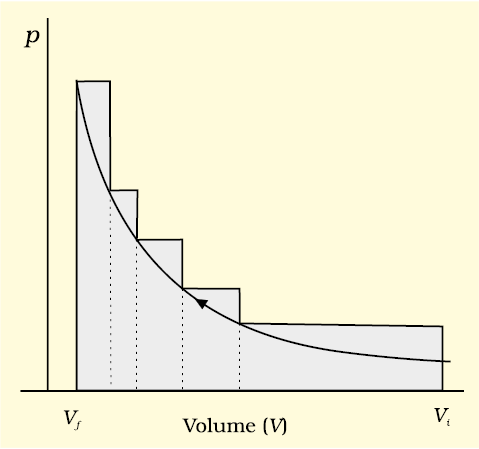
Fig. 6.5 (b) pV-plot when pressure is not constant and changes in finite steps during compression from initial volume, Vi to final volume, Vf . Work done on the gas is represented by the shaded area.
If the pressure is not constant but changes during the process such that it is always infinitesimally greater than the pressure of the gas, then, at each stage of compression, the volume decreases by an infinitesimal amount, dV. In such a case we can calculate the work done on the gas by the relation

Here, pex at each stage is equal to (pin + dp) in case of compression [Fig. 6.5(c)]. In an expansion process under similar conditions, the external pressure is always less than the pressure of the system i.e., pex = (pin– dp). In general case we can write, pex = (pin + dp). Such processes are called reversible processes.
A process or change is said to be reversible, if a change is brought out in such a way that the process could, at any moment, be reversed by an infinitesimal change. A reversible process proceeds infinitely slowly by a series of equilibrium states such that system and the surroundings are always in near equilibrium with each other. Processes other than reversible processes are known as irreversible processes.
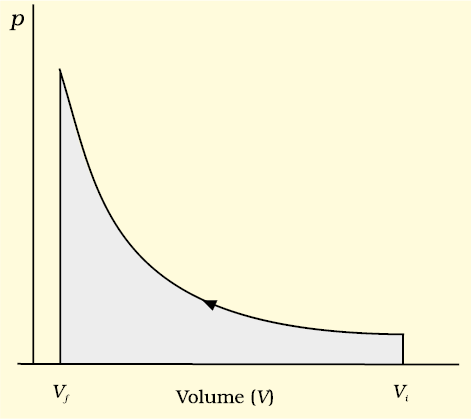
Fig. 6.5 (c) pV-plot when pressure is not constant and changes in infinite steps (reversible conditions) during compression from initial volume, Vi to final volume, Vf . Work done on the gas is represented by the shaded area.
In chemistry, we face problems that can be solved if we relate the work term to the internal pressure of the system. We can relate work to internal pressure of the system under reversible conditions by writing equation 6.3 as follows:
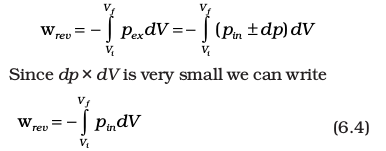
Now, the pressure of the gas (pin which we can write as p now) can be expressed in terms of its volume through gas equation. For n mol of an ideal gas i.e., pV =nRT

Therefore, at constant temperature (isothermal process),
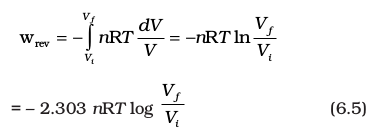
Free expansion : Expansion of a gas in vacuum (pex = 0) is called free expansion. No work is done during free expansion of an ideal gas whether the process is reversible or irreversible (equation 6.2 and 6.3).
Now, we can write equation 6.1 in number of ways depending on the type of processes.
Let us substitute w = – pex∆V (eq. 6.2) in equation 6.1, and we get

If a process is carried out at constant volume (∆V = 0), then
∆U = qV
the subscript V in qV denotes that heat is supplied at constant volume.
Isothermal and free expansion of an ideal gas
For isothermal (T = constant) expansion of an ideal gas into vacuum ; w = 0 since pex = 0. Also, Joule determined experimentally that
q = 0; therefore, ∆U = 0
Equation 6.1,  can be expressed for isothermal irreversible and reversible changes as follows:
can be expressed for isothermal irreversible and reversible changes as follows:
1. For isothermal irreversible change
q = – w = pex (Vf – Vi )
2. For isothermal reversible change
q = – w = nRT ln 
= 2.303 nRT log 
3. For adiabatic change, q = 0,
∆U = wad
Problem 6.2
Two litres of an ideal gas at a pressure of 10 atm expands isothermally at 25 °C into a vacuum until its total volume is 10 litres. How much heat is absorbed and how much work is done in the expansion ?
Solution
We have q = – w = pex (10 – 2) = 0(8) = 0
No work is done; no heat is absorbed.
Problem 6.3
Consider the same expansion, but this time against a constant external pressure of 1 atm.
Solution
We have q = – w = pex (8) = 8 litre-atm
Problem 6.4
Consider the expansion given in problem 6.2, for 1 mol of an ideal gas conducted reversibly.
Solution
We have q = – w = 2.303 nRT 
= 2.303 × 1 × 0.8206 × 298 × log 
= 2.303 x 0.8206 x 298 x log 5
= 2.303 x 0.8206 x 298 x 0.6990
= 393.66 L atm
6.2.2 Enthalpy, H
(a) A Useful New State Function
We know that the heat absorbed at constant volume is equal to change in the internal energy i.e., ∆U = qV. But most of chemical reactions are carried out not at constant volume, but in flasks or test tubes under constant atmospheric pressure. We need to define another state function which may be suitable under these conditions.
We may write equation (6.1) as
∆U = qp – p∆V at constant pressure, where qp is heat absorbed by the system and –p∆V represent expansion work done by the system.
Let us represent the initial state by subscript 1 and final state by 2
We can rewrite the above equation as
U2–U1 = qp – p (V2 – V1)
On rearranging, we get
qp = (U2 + pV2) – (U1 + pV1) (6.6)
Now we can define another thermodynamic function, the enthalpy H [Greek word enthalpien, to warm or heat content] as :
H = U + pV (6.7)
so, equation (6.6) becomes
qp= H2 – H1 = ∆H
Although q is a path dependent function, H is a state function because it depends on U, p and V, all of which are state functions. Therefore, ∆H is independent of path. Hence, qp is also independent of path.
For finite changes at constant pressure, we can write equation 6.7 as
∆H = ∆U + ∆pV
Since p is constant, we can write
∆H = ∆U + p∆V (6.8)
It is important to note that when heat is absorbed by the system at constant pressure, we are actually measuring changes in the enthalpy.
Remember ∆H = qp, heat absorbed by the system at constant pressure.
At constant volume (∆V = 0), ∆U = qV, therefore equation 6.8 becomes
∆H = ∆U = qV
The difference between ∆H and ∆U is not usually significant for systems consisting of only solids and / or liquids. Solids and liquids do not suffer any significant volume changes upon heating. The difference, however, becomes significant when gases are involved. Let us consider a reaction involving gases. If VA is the total volume of the gaseous reactants, VB is the total volume of the gaseous products, nA is the number of moles of gaseous reactants and nB is the number of moles of gaseous products, all at constant pressure and temperature, then using the ideal gas law, we write,
pVA = nART
and pVB = nBRT
Thus, pVB – pVA = nBRT – nART = (nB–nA)RT
or p (VB – VA) = (nB – nA) RT
or p ∆V = ∆ngRT (6.9)
Here, ∆ng refers to the number of moles of gaseous products minus the number of moles of gaseous reactants.
Substituting the value of p∆V from equation 6.9 in equation 6.8, we get
∆H = ∆U + ∆ngRT (6.10)
The equation 6.10 is useful for calculating ∆H from ∆U and vice versa.
Problem 6.5
If water vapour is assumed to be a perfect gas, molar enthalpy change for vapourisation of 1 mol of water at 1bar and 100°C is 41kJ mol–1. Calculate the internal energy change, when
1 mol of water is vapourised at 1 bar pressure and 100°C.
Solution

= 41.00 kJ mol-1 – 3.096 kJ mol-1
= 37.904 kJ mol–1
(b) Extensive and Intensive Properties
In thermodynamics, a distinction is made between extensive properties and intensive properties. An extensive property is a property whose value depends on the quantity or size of matter present in the system. For example, mass, volume, internal energy, enthalpy, heat capacity, etc. are extensive properties.
Those properties which do not depend on the quantity or size of matter present are known as intensive properties. For example temperature, density, pressure etc. are intensive properties. A molar property, χm, is the value of an extensive property χ of the system for 1 mol of the substance. If n is the amount of matter,  is independent of the amount of matter. Other examples are molar volume, Vm and molar heat capacity, Cm. Let us understand the distinction between extensive and intensive properties by considering a gas enclosed in a container of volume V and at temperature T [Fig. 6.6(a)]. Let us make a partition such that volume is halved, each part [Fig. 6.6 (b)] now has one half of the original volume,
is independent of the amount of matter. Other examples are molar volume, Vm and molar heat capacity, Cm. Let us understand the distinction between extensive and intensive properties by considering a gas enclosed in a container of volume V and at temperature T [Fig. 6.6(a)]. Let us make a partition such that volume is halved, each part [Fig. 6.6 (b)] now has one half of the original volume,  , but the temperature will still remain the same i.e., T. It is clear that volume is an extensive property and temperature is an intensive property.
, but the temperature will still remain the same i.e., T. It is clear that volume is an extensive property and temperature is an intensive property.
Fig. 6.6(a) A gas at volume V and temperature T

Fig. 6.6 (b) Partition, each part having half the volume of the gas
(c) Heat Capacity
In this sub-section, let us see how to measure heat transferred to a system. This heat appears as a rise in temperature of the system in case of heat absorbed by the system.
The increase of temperature is proportional to the heat transferred

The magnitude of the coefficient depends on the size, composition and nature of the system. We can also write it as q = C ∆T
The coefficient, C is called the heat capacity.
Thus, we can measure the heat supplied by monitoring the temperature rise, provided we know the heat capacity.
When C is large, a given amount of heat results in only a small temperature rise. Water has a large heat capacity i.e., a lot of energy is needed to raise its temperature.
C is directly proportional to amount of substance. The molar heat capacity of a substance,  , is the heat capacity for one mole of the substance and is the quantity of heat needed to raise the temperature of one mole by one degree celsius (or one kelvin). Specific heat, also called specific heat capacity is the quantity of heat required to raise the temperature of one unit mass of a substance by one degree celsius (or one kelvin). For finding out the heat, q, required to raise the temperatures of a sample, we multiply the specific heat of the substance, c, by the mass m, and temperatures change, ∆T as
, is the heat capacity for one mole of the substance and is the quantity of heat needed to raise the temperature of one mole by one degree celsius (or one kelvin). Specific heat, also called specific heat capacity is the quantity of heat required to raise the temperature of one unit mass of a substance by one degree celsius (or one kelvin). For finding out the heat, q, required to raise the temperatures of a sample, we multiply the specific heat of the substance, c, by the mass m, and temperatures change, ∆T as

(d) The Relationship between CP and CV for an Ideal Gas
At constant volume, the heat capacity, C is denoted by CV and at constant pressure, this is denoted by Cp . Let us find the relationship between the two.
We can write equation for heat, q
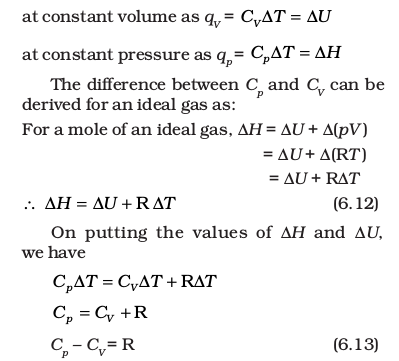
We can measure energy changes associated with chemical or physical processes by an experimental technique called calorimetry. In calorimetry, the process is carried out in a vessel called calorimeter, which is immersed in a known volume of a liquid. Knowing the heat capacity of the liquid in which calorimeter is immersed and the heat capacity of calorimeter, it is possible to determine the heat evolved in the process by measuring temperature changes. Measurements are made under two different conditions:
i) at constant volume, qV
ii) at constant pressure, qp
(a) ∆U Measurements
For chemical reactions, heat absorbed at constant volume, is measured in a bomb calorimeter (Fig. 6.7). Here, a steel vessel (the bomb) is immersed in a water bath. The whole device is called calorimeter. The steel vessel is immersed in water bath to ensure that no heat is lost to the surroundings. A combustible substance is burnt in pure dioxygen supplied in the steel bomb. Heat evolved during the reaction is transferred to the water around the bomb and its temperature is monitored. Since the bomb calorimeter is sealed, its volume does not change i.e., the energy changes associated with reactions are measured at constant volume. Under these conditions, no work is done as the reaction is carried out at constant volume in the bomb calorimeter. Even for reactions involving gases, there is no work done as ∆V = 0. Temperature change of the calorimeter produced by the completed reaction is then converted to qV, by using the known heat capacity of the calorimeter with the help of equation 6.11.
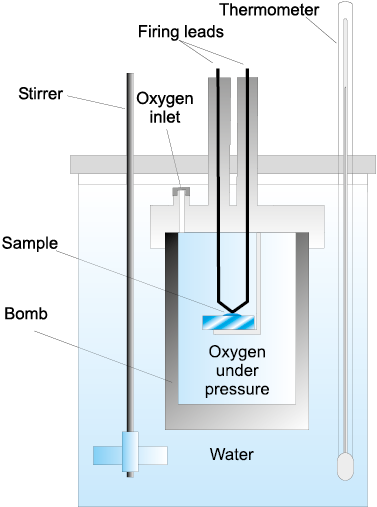
(b) ∆H Measurements
Measurement of heat change at constant pressure (generally under atmospheric pressure) can be done in a calorimeter shown in Fig. 6.8. We know that ∆Η = qp (at constant p) and, therefore, heat absorbed or evolved, qp at constant pressure is also called the heat of reaction or enthalpy of reaction, ∆rH.
In an exothermic reaction, heat is evolved, and system loses heat to the surroundings. Therefore, qp will be negative and ∆rH will also be negative. Similarly in an endothermic reaction, heat is absorbed, qp is positive and ∆rH will be positive.
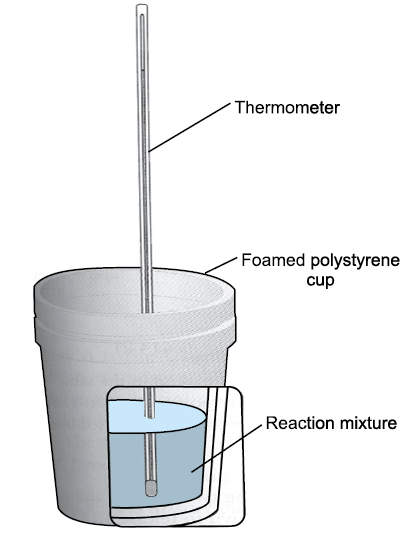
Problem 6.6
1g of graphite is burnt in a bomb calorimeter in excess of oxygen at 298 K and 1 atmospheric pressure according to the equation
C (graphite) + O2 (g) → CO2 (g)
During the reaction, temperature rises from 298 K to 299 K. If the heat capacity of the bomb calorimeter is 20.7kJ/K, what is the enthalpy change for the above reaction at 298 K and 1 atm?
Solution
Suppose q is the quantity of heat from the reaction mixture and CV is the heat capacity of the calorimeter, then the quantity of heat absorbed by the calorimeter.
q = CV × ∆T
Quantity of heat from the reaction will have the same magnitude but opposite sign because the heat lost by the system (reaction mixture) is equal to the heat gained by the calorimeter.

(Here, negative sign indicates the exothermic nature of the reaction)
Thus, ∆U for the combustion of the 1g of graphite = – 20.7 kJK–1
For combustion of 1 mol of graphite,

= – 2.48 ×102 kJ mol–1 , Since ∆ ng = 0,
∆ H = ∆ U = – 2.48 ×102 kJ mol–1
In a chemical reaction, reactants are converted into products and is represented by,
Reactants → Products
The enthalpy change accompanying a reaction is called the reaction enthalpy. The enthalpy change of a chemical reaction, is given by the symbol ∆rH
∆rH = (sum of enthalpies of products) – (sum of enthalpies of reactants)

Here symbol Σ (sigma) is used for summation and ai and bi are the stoichiometric coefficients of the products and reactants respectively in the balanced chemical equation. For example, for the reaction

= [Hm (CO2 ,g) + 2Hm (H2O, l)]– [Hm (CH4 , g) + 2Hm (O2, g)]
where Hm is the molar enthalpy.
Enthalpy change is a very useful quantity. Knowledge of this quantity is required when one needs to plan the heating or cooling required to maintain an industrial chemical reaction at constant temperature. It is also required to calculate temperature dependence of equilibrium constant.
(a) Standard Enthalpy of Reactions
Enthalpy of a reaction depends on the conditions under which a reaction is carried out. It is, therefore, necessary that we must specify some standard conditions. The standard enthalpy of reaction is the enthalpy change for a reaction when all the participating substances are in their standard states.
The standard state of a substance at a specified temperature is its pure form at 1 bar. For example, the standard state of liquid ethanol at 298 K is pure liquid ethanol at 1 bar; standard state of solid iron at 500 K is pure iron at 1 bar. Usually data are taken
at 298 K.
Standard conditions are denoted by adding the superscript 0 to the symbol ∆H, e.g., ∆H⊖
(b) Enthalpy Changes during Phase Transformations
Phase transformations also involve energy changes. Ice, for example, requires heat for melting. Normally this melting takes place at constant pressure (atmospheric pressure) and during phase change, temperature remains constant (at 273 K).
H2O(s) → H2O(l); ∆fusH⊖= 6.00 kJ moI–1
Here ∆fusH⊖ is enthalpy of fusion in standard state. If water freezes, then process is reversed and equal amount of heat is given off to the surroundings.
The enthalpy change that accompanies melting of one mole of a solid substance in standard state is called standard enthalpy of fusion or molar enthalpy of fusion, ∆fusH⊖.
Melting of a solid is endothermic, so all enthalpies of fusion are positive. Water requires heat for evaporation. At constant temperature of its boiling point Tb and at constant pressure:
Table 6.1 Standard Enthalpy Changes of Fusion and Vaporisation

(Tf and Tb are melting and boiling points, respectively)
H2O(l) → H2O(g); ∆vapH⊖= + 40.79 kJ moI–1 ∆vapH⊖is the standard enthalpy of vaporisation.
Amount of heat required to vaporize one mole of a liquid at constant temperature and under standard pressure (1bar) is called its standard enthalpy of vaporization or molar enthalpy of vaporization, ∆vapH⊖.
Sublimation is direct conversion of a solid into its vapour. Solid CO2 or ‘dry ice’ sublimes at 195K with ∆subH⊖=25.2 kJ mol–1; naphthalene sublimes slowly and for this ∆sub H⊖ = 73.0 kJ mol–1 .
Standard enthalpy of sublimation, ∆subH⊖ is the change in enthalpy when one mole of a solid substance sublimes at a constant temperature and under standard pressure (1bar).
The magnitude of the enthalpy change depends on the strength of the intermolecular interactions in the substance undergoing the phase transfomations. For example, the strong hydrogen bonds between water molecules hold them tightly in liquid phase. For an organic liquid, such as acetone, the intermolecular dipole-dipole interactions are significantly weaker. Thus, it requires less heat to vaporise 1 mol of acetone than it does to vaporize 1 mol of water. Table 6.1 gives values of standard enthalpy changes of fusion and vaporisation for some substances.
Problem 6.7
A swimmer coming out from a pool is covered with a film of water weighing about 18g. How much heat must be supplied to evaporate this water at
298 K ? Calculate the internal energy of vaporisation at 298K.
∆vap H⊖ for water
at 298K= 44.01kJ mol–1
Solution
We can represent the process of evaporation as
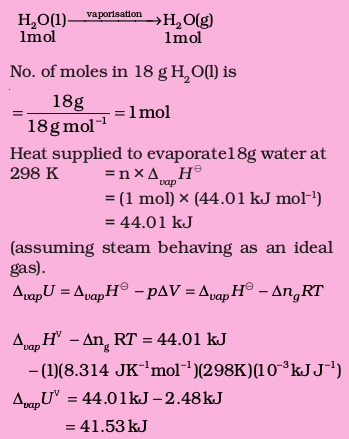
Table 6.2 Standard Molar Enthalpies of Formation (∆f H) at 298K of a Few Selected Substances
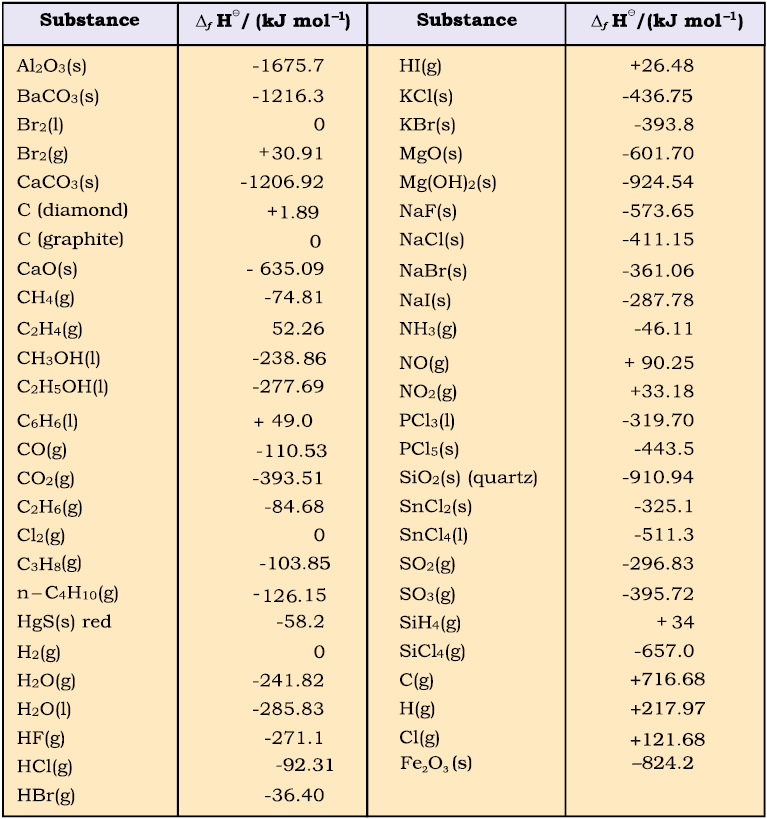
(c) Standard Enthalpy of Formation
The standard enthalpy change for the formation of one mole of a compound from its elements in their most stable states of aggregation (also known as reference states) is called Standard Molar Enthalpy of Formation. Its symbol is ∆fH0, where the subscript ‘ f ’ indicates that one mole of the compound in question has been formed in its standard state from its elements in their most stable states of aggregation. The reference state of an element is its most stable state of aggregation at 25°C and 1 bar pressure.
For example, the reference state of dihydrogen is H2 gas and those of dioxygen, carbon and sulphur are O2 gas, Cgraphite and Srhombic respectively. Some reactions with standard molar enthalpies of formation are as follows.
H2(g) + ½O2 (g) → H2O(1);
∆f H⊖ = –285.8 kJ mol–1
C (graphite, s) + 2H2(g) → Ch4 (g);
∆f H⊖ = –74.81 kJ mol–1
2C (graphite, s)+3H2 (g)+ ½O2(g) → C2H5OH(1);
∆f H⊖ = – 277.7kJ mol–1
It is important to understand that a standard molar enthalpy of formation, ∆fH⊖, is just a special case of ∆rH⊖, where one mole of a compound is formed from its constituent elements, as in the above three equations, where 1 mol of each, water, methane and ethanol is formed. In contrast, the enthalpy change for an exothermic reaction:
CaO(s) + CO2(g) → CaCo3(s);
∆rH⊖= – 178.3kJ mol–1
is not an enthalpy of formation of calcium carbonate, since calcium carbonate has been formed from other compounds, and not from its constituent elements. Also, for the reaction given below, enthalpy change is not standard enthalpy of formation, ∆fH⊖ for HBr(g).
H2(g) + Br2(l) → 2HBr(g);
∆r H⊖= – 178.3kJ mol–1
Here two moles, instead of one mole of the product is formed from the elements, i.e., .
∆r H⊖= 2∆f H⊖
Therefore, by dividing all coefficients in the balanced equation by 2, expression for enthalpy of formation of HBr (g) is written as
½H2(g) + ½Br2(1) → HBr(g);
∆f H⊖= – 36.4 kJ mol–1
Standard enthalpies of formation of some common substances are given in Table 6.2.
By convention, standard enthalpy for formation, ∆fH⊖, of an element in reference state, i.e., its most stable state of aggregation is taken as zero.
Suppose, you are a chemical engineer and want to know how much heat is required to decompose calcium carbonate to lime and carbon dioxide, with all the substances in their standard state.
CaCO3(s) → CaO(s) + CO2(g); ∆r H⊖ = ?
Here, we can make use of standard enthalpy of formation and calculate the enthalpy change for the reaction. The following general equation can be used for the enthalpy change calculation.
∆rH⊖=  ai ∆f H⊖(products) –
ai ∆f H⊖(products) –  bi ∆f H⊖(reactants) (6.15)
bi ∆f H⊖(reactants) (6.15)
where a and b represent the coefficients of the products and reactants in the balanced equation. Let us apply the above equation for decomposition of calcium carbonate. Here, coefficients ‘a’ and ‘b’ are 1 each. Therefore,
∆rH⊖= ∆f H⊖= [CaO(s)]+ ∆f H⊖[CO2(g)]
– ∆f H⊖= [CaCO3(s)]
=1 (–635.1 kJ mol–1) + 1(–393.5 kJ mol–1)
–1(–1206.9 kJ mol–1)
= 178.3 kJ mol–1
Thus, the decomposition of CaCO3 (s) is an endothermic process and you have to heat it for getting the desired products.
(d) Thermochemical Equations
A balanced chemical equation together with the value of its ∆rH is called a thermochemical equation. We specify the physical state (alongwith allotropic state) of the substance in an equation. For example:
C2H5OH(l) + 3O2(g) → 2CO2(g) + 3H2O(l);
∆rH⊖= – 1367 kJ mol–1
The above equation describes the combustion of liquid ethanol at constant temperature and pressure. The negative sign of enthalpy change indicates that this is an exothermic reaction.
It would be necessary to remember the following conventions regarding thermo-chemical equations.
1. The coefficients in a balanced thermo-chemical equation refer to the number of moles (never molecules) of reactants and products involved in the reaction.
2. The numerical value of ∆rH⊖ refers to the number of moles of substances specified by an equation. Standard enthalpy change ∆rH⊖ will have units as kJ mol–1.
To illustrate the concept, let us consider the calculation of heat of reaction for the following reaction :

From the Table (6.2) of standard enthalpy of formation (∆f H⊖), we find :
∆f H⊖ (H2O,l) = –285.83 kJ mol–1;
∆f H⊖ (Fe2O3,s) = – 824.2 kJ mol–1;
Also ∆f H⊖ (Fe, s) = 0 and
∆f H⊖ (H2, g) = 0 as per convention
Then,
∆f H1⊖ = 3(–285.83 kJ mol–1)
– 1(– 824.2 kJ mol–1)
= (–857.5 + 824.2) kJ mol–1
= –33.3 kJ mol–1
Note that the coefficients used in these calculations are pure numbers, which are equal to the respective stoichiometric coefficients. The unit for ∆rH⊖ is kJ mol–1, which means per mole of reaction. Once we balance the chemical equation in a particular way, as above, this defines the mole of reaction. If we had balanced the equation differently, for example,

then this amount of reaction would be one mole of reaction and ∆rH⊖ would be
∆f H2⊖ =  (–285.83 kJ mol–1)
(–285.83 kJ mol–1)
–  (–824.2 kJ mol–1)
(–824.2 kJ mol–1)
= (– 428.7 + 412.1) kJ mol–1
= –16.6 kJ mol–1 = ½ ∆r H1⊖
It shows that enthalpy is an extensive quantity.
3. When a chemical equation is reversed, the value of ∆rH⊖is reversed in sign. For example
N2(g) + 3H2 (g) → 2NH3 (g);
∆r H⊖= – 91.8 kJ. mol–1
2NH3(g) → N2(g) + 3H2 (g);
∆r H⊖= + 91.8 kJ mol–1
(e) Hess’s Law of Constant Heat Summation
We know that enthalpy is a state function, therefore the change in enthalpy is independent of the path between initial state (reactants) and final state (products). In other words, enthalpy change for a reaction is the same whether it occurs in one step or in a series of steps. This may be stated as follows in the form of Hess’s Law.
If a reaction takes place in several steps then its standard reaction enthalpy is the sum of the standard enthalpies of the intermediate reactions into which the overall reaction may be divided at the same temperature.
Let us understand the importance of this law with the help of an example.
Consider the enthalpy change for the reaction
C (graphite,s) +  O2 (g) → CO (g); ∆r H⊖= ?
O2 (g) → CO (g); ∆r H⊖= ?
Although CO(g) is the major product, some CO2 gas is always produced in this reaction. Therefore, we cannot measure enthalpy change for the above reaction directly. However, if we can find some other reactions involving related species, it is possible to calculate the enthalpy change for the above reaction.
Let us consider the following reactions:
C (graphite,s) + O2 (g) → CO2 (g);
∆r H⊖= – 393.5 kJ mol–1 (i)
CO (g) +  O2 (g) → CO2 (g)
O2 (g) → CO2 (g)
∆r H⊖= – 283.0 kJ mol–1 (ii)
We can combine the above two reactions in such a way so as to obtain the desired reaction. To get one mole of CO(g) on the right, we reverse equation (ii). In this, heat is absorbed instead of being released, so we change sign of ∆rH⊖ value
CO2 (g) → CO (g) +  O2 (g);
O2 (g);
∆r H⊖= + 283.0 kJ mol–1 (iii)
Adding equation (i) and (iii), we get the desired equation,

for which ∆r H⊖ = (– 393.5 + 283.0)
= – 110.5 kJ mol–1
In general, if enthalpy of an overall reaction A→B along one route is ∆rH and ∆rH1, ∆rH2, ∆rH3..... representing enthalpies of reactions leading to same product, B along another route,then we have
∆rH = ∆rH1 + ∆rH2 + ∆rH3 ... (6.16)
It can be represented as:
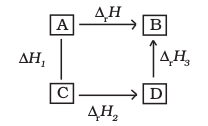
It is convenient to give name to enthalpies specifying the types of reactions.
(a) Standard Enthalpy of Combustion (symbol : ∆cH⊖)
Combustion reactions are exothermic in nature. These are important in industry, rocketry, and other walks of life. Standard enthalpy of combustion is defined as the enthalpy change per mole (or per unit amount) of a substance, when it undergoes combustion and all the reactants and products being in their standard states at the specified temperature.
Cooking gas in cylinders contains mostly butane (C4H10). During complete combustion of one mole of butane, 2658 kJ of heat is released. We can write the thermochemical reactions for this as:

Similarly, combustion of glucose gives out 2802.0 kJ/mol of heat, for which the overall equation is :

Our body also generates energy from food by the same overall process as combustion, although the final products are produced after a series of complex bio-chemical reactions involving enzymes.
Problem 6.8
The combustion of one mole of benzene takes place at 298 K and 1 atm. After combustion, CO2(g) and H2O (1) are produced and 3267.0 kJ of heat is liberated. Calculate the standard enthalpy of formation, ∆f H⊖ of benzene. Standard enthalpies of formation of CO2(g) and  are –393.5 kJ mol–1 and – 285.83 kJ mol–1 respectively.
are –393.5 kJ mol–1 and – 285.83 kJ mol–1 respectively.
Solution
The formation reaction of benezene is given by :
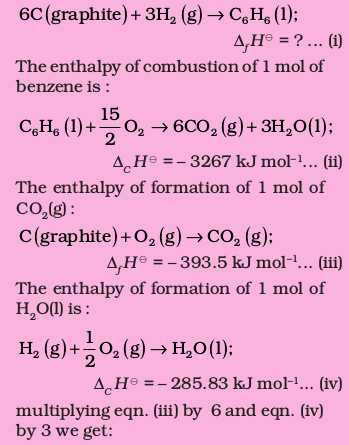

(b) Enthalpy of Atomization (symbol: ∆aH⊖)
Consider the following example of atomization of dihydrogen
H2(g) → 2H(g); ∆aH⊖ = 435.0 kJ mol–1
You can see that H atoms are formed by breaking H–H bonds in dihydrogen. The enthalpy change in this process is known as enthalpy of atomization, ∆aH⊖. It is the enthalpy change on breaking one mole of bonds completely to obtain atoms in the gas phase.
In case of diatomic molecules, like dihydrogen (given above), the enthalpy of atomization is also the bond dissociation enthalpy. The other examples of enthalpy of atomization can be
CH4(g) → C(g) + 4H(g); ∆aH⊖ = 1665 kJ mol–1
Note that the products are only atoms of C and H in gaseous phase. Now see the following reaction:
Na(s) → Na(g) ; ∆aH⊖ = 108.4 kJ mol–1
In this case, the enthalpy of atomization is same as the enthalpy of sublimation.
(c) Bond Enthalpy (symbol: ∆bondH⊖)
Chemical reactions involve the breaking and making of chemical bonds. Energy is required to break a bond and energy is released when a bond is formed. It is possible to relate heat of reaction to changes in energy associated with breaking and making of chemical bonds. With reference to the enthalpy changes associated with chemical bonds, two different terms are used in thermodynamics.
(i) Bond dissociation enthalpy
(ii) Mean bond enthalpy
Let us discuss these terms with reference to diatomic and polyatomic molecules.
Diatomic Molecules: Consider the following process in which the bonds in one mole of dihydrogen gas (H2) are broken:
H2(g) → 2H(g) ; ∆H–HH⊖ = 435.0 kJ mol–1
The enthalpy change involved in this process is the bond dissociation enthalpy of H–H bond. The bond dissociation enthalpy is the change in enthalpy when one mole of covalent bonds of a gaseous covalent compound is broken to form products in the gas phase.
Note that it is the same as the enthalpy of atomization of dihydrogen. This is true for all diatomic molecules. For example:
Cl2(g) → 2Cl(g) ; ∆Cl–ClH⊖ = 242 kJ mol–1
O2(g) → 2O(g) ; ∆O=OH⊖ = 428 kJ mol–1
In the case of polyatomic molecules, bond dissociation enthalpy is different for different bonds within the same molecule.
Let us now consider a polyatomic molecule like methane, CH4. The overall thermochemical equation for its atomization reaction is given below:

∆a H⊖ = 1665 kJ mol–1
In methane, all the four C – H bonds are identical in bond length and energy. However, the energies required to break the individual C – H bonds in each successive step differ :
CH4(g) → CH3(g)+H(g);∆bond H⊖= +427 kJ mol–1
CH3(g) → CH2(g)+H(g);∆bond H⊖= +439 kJ mol–1
CH2(g) → CH(g)+H(g);∆bond H⊖= +452 kJ mol–1
CH(g) → C(g)+H(g);∆bond H⊖= +347 kJ mol–1
Therefore,
CH4(g) → C(g)+4H(g);∆a H⊖= 1665 kJ mol–1
In such cases we use mean bond enthalpy of C – H bond.
For example in CH4, ∆C–HH⊖ is calculated as:
∆C–HH⊖= ¼ (∆a H⊖) = ¼ (1665 kJ mol–1)
= 416 kJ mol–1
We find that mean C–H bond enthalpy in methane is 416 kJ/mol. It has been found that mean C–H bond enthalpies differ slightly from compound to compound, as in CH3CH2Cl,CH3NO2, etc, but it does not differ in a great deal*. Using Hess’s law, bond enthalpies can be calculated. Bond enthalpy values of some single and multiple bonds are given in Table 6.3. The reaction enthalpies are very important quantities as these arise from the changes that accompany the breaking of old bonds and formation of the new bonds. We can predict enthalpy of a reaction in gas phase, if we know different bond enthalpies. The standard enthalpy of reaction, ∆rH⊖ is related to bond enthalpies of the reactants and products in gas phase reactions as:

This relationship is particularly more useful when the required values of ∆f H⊖ are not available. The net enthalpy change of a reaction is the amount of energy required to break all the bonds in the reactant molecules minus the amount of energy required to break all the bonds in the product molecules. Remember that this relationship is approximate and is valid when all substances (reactants and products) in the reaction are in gaseous state.

(d) Lattice Enthalpy
The lattice enthalpy of an ionic compound is the enthalpy change which occurs when one mole of an ionic compound dissociates into its ions in gaseous state.

Since it is impossible to determine lattice enthalpies directly by experiment, we use an indirect method where we construct an enthalpy diagram called a Born-Haber Cycle (Fig. 6.9).
Let us now calculate the lattice enthalpy of Na+Cl–(s) by following steps given below :
1. Na ( s ) → Na ( g ), sublimation of sodium metal, ∆subH⊖= 108.4 kJ mol–1
2. Na ( g ) → Na+ ( g ) + e−1( g ) ,, the ionization of sodium atoms, ionization enthalpy ∆iH⊖= 496 kJ mol–1
3.  , the dissociation of chlorine, the reaction enthalpy is half the bond dissociation enthalpy.
, the dissociation of chlorine, the reaction enthalpy is half the bond dissociation enthalpy.

4.  electron gained by chlorine atoms. The electron gain enthalpy, ∆egH 0 = – 348.6 kJ mol–1.
electron gained by chlorine atoms. The electron gain enthalpy, ∆egH 0 = – 348.6 kJ mol–1.
You have learnt about ionization enthalpy and electron gain enthalpy in Unit 3. In fact, these terms have been taken from thermodynamics. Earlier terms, ionization energy and electron affinity were in practice in place of the above terms (see the box for justification).
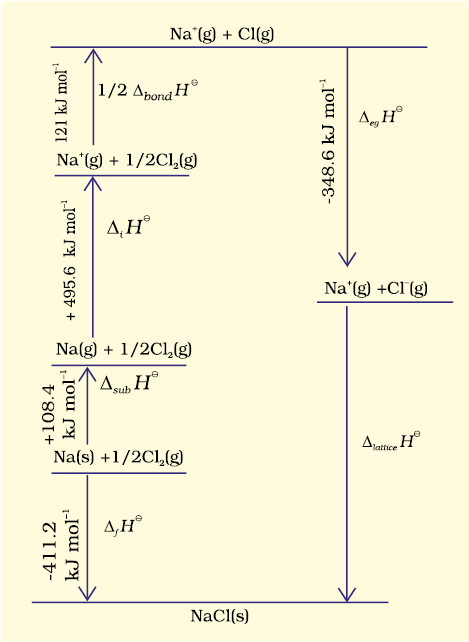
Fig. 6.9 Enthalpy diagram for lattice enthalpy of NaCl
Ionization Energy and Electron Affinity
Ionization energy and electron affinity are defined at absolute zero. At any other temperature, heat capacities for the reactants and the products have to be taken into account. Enthalpies of reactions for
M(g) → M+(g) + e– (for ionization)
M(g) + e– → M–(g) (for electron gain)
at temperature, T is
∆rH⊖(T ) = ∆rH⊖(0) +  ∆rCP⊖dT
∆rCP⊖dT
The value of Cp for each species in the above reaction is 5/2 R (CV = 3/2R)
So, ∆rCp⊖ = + 5/2 R (for ionization)
∆rCp⊖ = – 5/2 R (for electron gain)
Therefore,
∆rH0 (ionization enthalpy)
= E0 (ionization energy) + 5/2 RT
∆rH0 (electron gain enthalpy)
= – A( electron affinity) – 5/2 RT
5. 
The sequence of steps is shown in Fig. 6.9, and is known as a Born-Haber cycle. The importance of the cycle is that, the sum of the enthalpy changes round a cycle is zero. Applying Hess’s law, we get,
∆latticeH⊖= 411.2 + 108.4 + 121 + 496 – 348.6
∆latticeH⊖= + 788kJ
for NaCl(s) d Na+(g) + Cl–(g)
Internal energy is smaller by 2RT ( because ∆ng = 2) and is equal to + 783 kJ mol–1.
Now we use the value of lattice enthalpy to calculate enthalpy of solution from the expression:
∆solH⊖= ∆latticeH⊖+ ∆hydH⊖
For one mole of NaCl(s),
lattice enthalpy = + 788 kJ mol–1
and ∆hydH⊖ = – 784 kJ mol–1( from the literature)
∆sol H⊖ = + 788 kJ mol–1 – 784 kJ mol–1
= + 4 kJ mol–1
The dissolution of NaCl(s) is accompanied by very little heat change.
(e) Enthalpy of Solution (symbol : ∆solH⊖ )
Enthalpy of solution of a substance is the enthalpy change when one mole of it dissolves in a specified amount of solvent. The enthalpy of solution at infinite dilution is the enthalpy change observed on dissolving the substance in an infinite amount of solvent when the interactions between the ions (or solute molecules) are negligible.
When an ionic compound dissolves in a solvent, the ions leave their ordered positions on the crystal lattice. These are now more free in solution. But solvation of these ions (hydration in case solvent is water) also occurs at the same time. This is shown diagrammatically, for an ionic compound, AB (s)
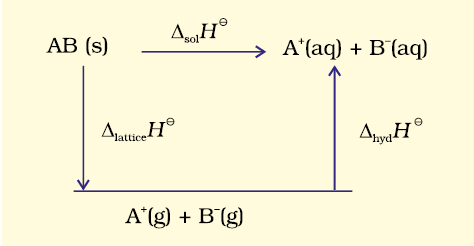
The enthalpy of solution of AB(s), ∆solH⊖, in water is, therefore, determined by the selective values of the lattice enthalpy,∆latticeH⊖ and enthalpy of hydration of ions, ∆hydH⊖ as
∆sol H ⊖= ∆latticeH ⊖+ ∆hydH ⊖
For most of the ionic compounds, ∆sol H⊖ is positive and the dissociation process is endothermic. Therefore the solubility of most salts in water increases with rise of temperature. If the lattice enthalpy is very high, the dissolution of the compound may not take place at all. Why do many fluorides tend to be less soluble than the corresponding chlorides? Estimates of the magnitudes of enthalpy changes may be made by using tables of bond energies (enthalpies) and lattice energies (enthalpies).
(f) Enthalpy of Dilution
It is known that enthalpy of solution is the enthalpy change associated with the addition of a specified amount of solute to the specified amount of solvent at a constant temperature and pressure. This argument can be applied to any solvent with slight modification. Enthalpy change for dissolving one mole of gaseous hydrogen chloride in 10 mol of water can be represented by the following equation. For convenience we will use the symbol aq. for water
HCl(g) + 10 aq. → HCl.10 aq.
∆H = –69.01 kJ / mol
Let us consider the following set of enthalpy changes:
(S-1) HCl(g) + 25 aq. → HCl.25 aq. ∆H = –72.03 kJ / mol
(S-2) HCl(g) + 40 aq. → HCl.40 aq. ∆H = –72.79 kJ / mol
(S-3) HCl(g) + ∞ aq. → HCl. ∞ aq. ∆H = –74.85 kJ / mol
The values of ∆H show general dependence of the enthalpy of solution on amount of solvent. As more and more solvent is used, the enthalpy of solution approaches a limiting value, i.e, the value in infinitely dilute solution. For hydrochloric acid this value of ∆H is given above in equation (S-3).
If we subtract the first equation (equation S-1) from the second equation (equation S-2) in the above set of equations, we obtain–
HCl.25 aq. + 15 aq. → HCl.40 aq.
∆H = [ –72.79 – (–72.03)] kJ / mol
= – 0.76 kJ / mol
This value (–0.76kJ/mol) of ∆H is enthalpy of dilution. It is the heat withdrawn from the surroundings when additional solvent is added to the solution. The enthalpy of dilution of a solution is dependent on the original concentration of the solution and the amount of solvent added.
The first law of thermodynamics tells us about the relationship between the heat absorbed and the work performed on or by a system. It puts no restrictions on the direction of heat flow. However, the flow of heat is unidirectional from higher temperature to lower temperature. In fact, all naturally occurring processes whether chemical or physical will tend to proceed spontaneously in one direction only. For example, a gas expanding to fill the available volume, burning carbon in dioxygen giving carbon dioxide.
But heat will not flow from colder body to warmer body on its own, the gas in a container will not spontaneously contract into one corner or carbon dioxide will not form carbon and dioxygen spontaneously. These and many other spontaneously occurring changes show unidirectional change. We may ask ‘what is the driving force of spontaneously occurring changes ? What determines the direction of a spontaneous change ? In this section, we shall establish some criterion for these processes whether these will take place or not.
Let us first understand what do we mean by spontaneous reaction or change ? You may think by your common observation that spontaneous reaction is one which occurs immediately when contact is made between the reactants. Take the case of combination of hydrogen and oxygen. These gases may be mixed at room temperature and left for many years without observing any perceptible change. Although the reaction is taking place between them, it is at an extremely slow rate. It is still called spontaneous reaction. So spontaneity means ‘having the potential to proceed without the assistance of external agency’. However, it does not tell about the rate of the reaction or process. Another aspect of spontaneous reaction or process, as we see is that these cannot reverse their direction on their own. We may summarise it as follows:
A spontaneous process is an irreversible process and may only be reversed by some external agency.
(a) Is Decrease in Enthalpy a Criterion for Spontaneity ?
If we examine the phenomenon like flow of water down hill or fall of a stone on to the ground, we find that there is a net decrease in potential energy in the direction of change. By analogy, we may be tempted to state that a chemical reaction is spontaneous in a given direction, because decrease in energy has taken place, as in the case of exothermic reactions. For example:
 N2(g) +
N2(g) +  H2(g) = NH3(g) ;
H2(g) = NH3(g) ;
∆r H⊖ = – 46.1 kJ mol–1
 H2(g) +
H2(g) +  Cl2(g) = HCl (g) ;
Cl2(g) = HCl (g) ;
∆r H⊖ = – 92.32 kJ mol–1
H2(g) +  O2(g) → H2O(l) ;
O2(g) → H2O(l) ;
∆r H⊖ = –285.8 kJ mol–1
The decrease in enthalpy in passing from reactants to products may be shown for any exothermic reaction on an enthalpy diagram as shown in Fig. 6.10(a).
Thus, the postulate that driving force for a chemical reaction may be due to decrease in energy sounds ‘reasonable’ as the basis of evidence so far !
Now let us examine the following reactions:
 N2(g) + O2(g) → NO2(g);
N2(g) + O2(g) → NO2(g);
∆r H⊖ = +33.2 kJ mol–1
C(graphite, s) + 2 S(l) → CS2(l);
∆r H⊖ = +128.5 kJ mol–1
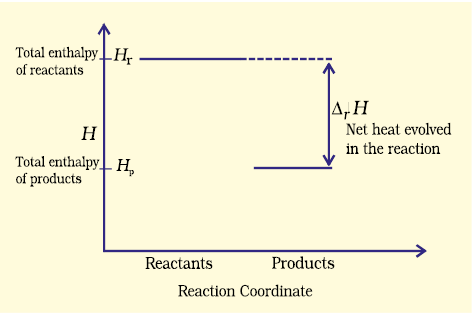
Fig. 6.10 (a) Enthalpy diagram for exothermic reactions
These reactions though endothermic, are spontaneous. The increase in enthalpy may be represented on an enthalpy diagram as shown in Fig. 6.10(b).
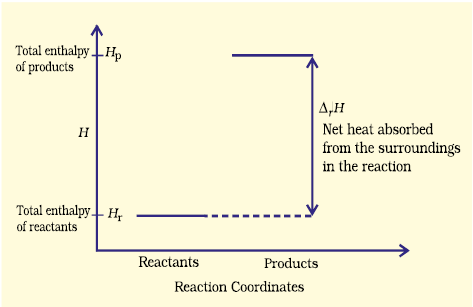
Fig. 6.10 (b) Enthalpy diagram for endothermic reactions
Therefore, it becomes obvious that while decrease in enthalpy may be a contributory factor for spontaneity, but it is not true for all cases.
(b) Entropy and Spontaneity
Then, what drives the spontaneous process in a given direction ? Let us examine such a case in which ∆H = 0 i.e., there is no change in enthalpy, but still the process is spontaneous.
Let us consider diffusion of two gases into each other in a closed container which is isolated from the surroundings as shown in Fig. 6.11.
The two gases, say, gas A and gas B are represented by black dots and white dots respectively and separated by a movable partition [Fig. 6.11 (a)]. When the partition is withdrawn [Fig.6.11( b)], the gases begin to diffuse into each other and after a period of time, diffusion will be complete.
Let us examine the process. Before partition, if we were to pick up the gas molecules from left container, we would be sure that these will be molecules of gas A and similarly if we were to pick up the gas molecules from right container, we would be sure that these will be molecules of gas B. But, if we were to pick up molecules from container when partition is removed, we are not sure whether the molecules picked are of gas A or gas B. We say that the system has become less predictable or more chaotic.
We may now formulate another postulate: in an isolated system, there is always a tendency for the systems’ energy to become more disordered or chaotic and this could be a criterion for spontaneous change !
Fig. 6.11 Diffusion of two gases
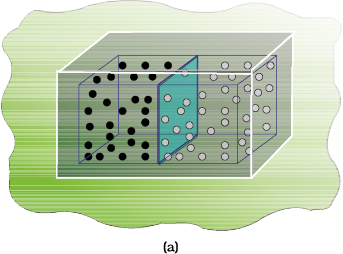
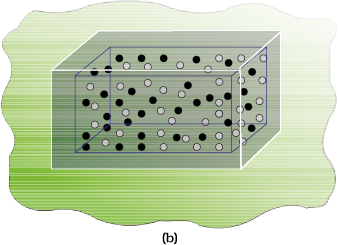
At this point, we introduce another thermodynamic function, entropy denoted as S. The above mentioned disorder is the manifestation of entropy. To form a mental picture, one can think of entropy as a measure of the degree of randomness or disorder in the system. The greater the disorder in an isolated system, the higher is the entropy. As far as a chemical reaction is concerned, this entropy change can be attributed to rearrangement of atoms or ions from one pattern in the reactants to another (in the products). If the structure of the products is very much disordered than that of the reactants, there will be a resultant increase in entropy. The change in entropy accompanying a chemical reaction may be estimated qualitatively by a consideration of the structures of the species taking part in the reaction. Decrease of regularity in structure would mean increase in entropy. For a given substance, the crystalline solid state is the state of lowest entropy (most ordered), The gaseous state is state of highest entropy.
Now let us try to quantify entropy. One way to calculate the degree of disorder or chaotic distribution of energy among molecules would be through statistical method which is beyond the scope of this treatment. Other way would be to relate this process to the heat involved in a process which would make entropy a thermodynamic concept. Entropy, like any other thermodynamic property such as internal energy U and enthalpy H is a state function and ∆S is independent of path.
Whenever heat is added to the system, it increases molecular motions causing increased randomness in the system. Thus heat (q) has randomising influence on the system. Can we then equate ∆S with q ? Wait ! Experience suggests us that the distribution of heat also depends on the temperature at which heat is added to the system. A system at higher temperature has greater randomness in it than one at lower temperature. Thus, temperature is the measure of average chaotic motion of particles in the system. Heat added to a system at lower temperature causes greater randomness than when the same quantity of heat is added to it at higher temperature. This suggests that the entropy change is inversely proportional to the temperature. ∆S is related with q and T for a reversible reaction as :

The total entropy change ( ∆Stotal) for the system and surroundings of a spontaneous process is given by

When a system is in equilibrium, the entropy is maximum, and the change in entropy, ∆S = 0.
We can say that entropy for a spontaneous process increases till it reaches maximum and at equilibrium the change in entropy is zero. Since entropy is a state property, we can calculate the change in entropy of a reversible process by

We find that both for reversible and irreversible expansion for an ideal gas, under isothermal conditions, ∆U = 0, but ∆Stotal i.e., ∆Ssys + ∆surr is not zero for irreversible process. Thus, ∆U does not discriminate between reversible and irreversible process, whereas ∆S does.
Problem 6.9
(i) A liquid crystallizes into a solid.
(ii) Temperature of a crystalline solid is raised from 0 K to 115 K.

Solution
(i) After freezing, the molecules attain an ordered state and therefore, entropy decreases.
(ii) At 0 K, the contituent particles are static and entropy is minimum. If temperature is raised to 115 K, these begin to move and oscillate about their equilibrium positions in the lattice and system becomes more disordered, therefore entropy increases.
(iii) Reactant, NaHCO3 is a solid and it has low entropy. Among products there are one solid and two gases. Therefore, the products represent a condition of higher entropy.
Problem 6.10
For oxidation of iron,
entropy change is – 549.4 JK–1 mol–1 at 298 K. Inspite of negative entropy change
of this reaction, why is the reaction spontaneous? ( for this reaction is –1648 × 103 J mol –1)
Solution
One decides the spontaneity of a reaction by considering
. For calculating , we have to consider the heat
absorbed by the surroundings which is equal to . At temperature T, entropy
change of the surroundings is
Thus, total entropy change for this reaction
This shows that the above reaction is spontaneous.
(c) Gibbs Energy and Spontaneity
We have seen that for a system, it is the total entropy change, ∆Stotal which decides the spontaneity of the process. But most of the chemical reactions fall into the category of either closed systems or open systems. Therefore, for most of the chemical reactions there are changes in both enthalpy and entropy. It is clear from the discussion in previous sections that neither decrease in enthalpy nor increase in entropy alone can determine the direction of spontaneous change for these systems.
For this purpose, we define a new thermodynamic function the Gibbs energy or Gibbs function, G, as
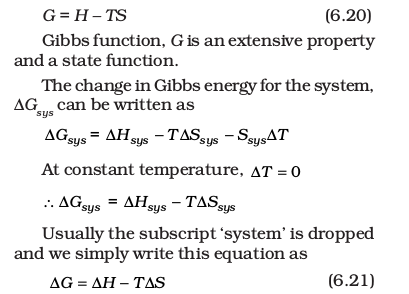
Thus, Gibbs energy change = enthalpy change – temperature × entropy change, and is referred to as the Gibbs equation, one of the most important equations in chemistry. Here, we have considered both terms together for spontaneity: energy (in terms of ∆H) and entropy (∆S, a measure of disorder) as indicated earlier. Dimensionally if we analyse, we find that ∆G has units of energy because, both ∆H and the T∆S are energy terms, since T∆S = (K) (J/K) = J.
Now let us consider how ∆G is related to reaction spontaneity.
We know,
∆Stotal = ∆Ssys + ∆Ssurr
If the system is in thermal equilibrium with the surrounding, then the temperature of the surrounding is same as that of the system. Also, increase in enthalpy of the surrounding is equal to decrease in the enthalpy of the system.
Therefore, entropy change of surroundings,

∆Hsys is the enthalpy change of a reaction, T∆Ssys is the energy which is not available to do useful work. So ∆G is the net energy available to do useful work and is thus a measure of the ‘free energy’. For this reason, it is also known as the free energy of the reaction.
∆G gives a criteria for spontaneity at constant pressure and temperature.
(i) If ∆G is negative (< 0), the process is spontaneous.
(ii) If ∆G is positive (> 0), the process is non spontaneous.
Note : If a reaction has a positive enthalpy change and positive entropy change, it can be spontaneous when T∆S is large enough to outweigh ∆H. This can happen in two ways; (a) The positive entropy change of the system can be ‘small’ in which case T must be large. (b) The positive entropy change of the system can be ’large’, in which case T may be small. The former is one of the reasons why reactions are often carried out at high temperature. Table 6.4 summarises the effect of temperature on spontaneity of reactions.
(d) Entropy and Second Law of Thermodynamics
We know that for an isolated system the change in energy remains constant. Therefore, increase in entropy in such systems is the natural direction of a spontaneous change. This, in fact is the second law of thermodynamics. Like first law of thermodynamics, second law can also be stated in several ways. The second law of thermodynamics explains why spontaneous exothermic reactions are so common. In exothermic reactions heat released by the reaction increases the disorder of the surroundings and overall entropy change is positive which makes the reaction spontaneous.
(e) Absolute Entropy and Third Law of Thermodynamics
Molecules of a substance may move in a straight line in any direction, they may spin like a top and the bonds in the molecules may stretch and compress. These motions of the molecule are called translational, rotational and vibrational motion respectively. When temperature of the system rises, these motions become more vigorous and entropy increases. On the other hand when temperature is lowered, the entropy decreases. The entropy of any pure crystalline substance approaches zero as the temperature approaches absolute zero. This is called third law of thermodynamics. This is so because there is perfect order in a crystal at absolute zero. The statement is confined to pure crystalline solids because theoretical arguments and practical evidences have shown that entropy of solutions and super cooled liquids is not zero at 0 K. The importance of the third law lies in the fact that it permits the calculation of absolute values of entropy of pure substance from thermal data alone. For a pure substance, this can be done by summing  increments from 0 K to 298 K. Standard entropies can be used to calculate standard entropy changes by a Hess’s law type of calculation.
increments from 0 K to 298 K. Standard entropies can be used to calculate standard entropy changes by a Hess’s law type of calculation.
We have seen how a knowledge of the sign and magnitude of the free energy change of a chemical reaction allows:
(i) Prediction of the spontaneity of the chemical reaction.
(ii) Prediction of the useful work that could be extracted from it.
So far we have considered free energy changes in irreversible reactions. Let us now examine the free energy changes in reversible reactions.
‘Reversible’ under strict thermodynamic sense is a special way of carrying out a process such that system is at all times in perfect equilibrium with its surroundings. When applied to a chemical reaction, the term ‘reversible’ indicates that a given reaction can proceed in either direction simultaneously, so that a dynamic equilibrium is set up. This means that the reactions in both the directions should proceed with a decrease in free energy, which seems impossible. It is possible only if at equilibrium the free energy of the system is minimum. If it is not, the system would spontaneously change to configuration of lower free energy.
So, the criterion for equilibrium
A + B ⇋ C + D ; is
∆rG = 0
Gibbs energy for a reaction in which all reactants and products are in standard state, ∆rG⊖ is related to the equilibrium constant of the reaction as follows:
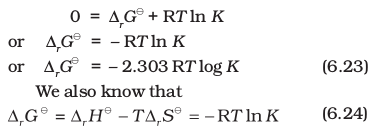
For strongly endothermic reactions, the value of ∆rH⊖ may be large and positive. In such a case, value of K will be much smaller
than 1 and the reaction is unlikely to form much product. In case of exothermic reactions, ∆rH⊖ is large and negative, and ∆rG⊖ is likely to be large and negative too. In such cases, K will be much larger than 1. We may expect strongly exothermic reactions to have a large K, and hence can go to near completion. ∆rG⊖ also depends upon ∆rS⊖, if the changes in the entropy of reaction is also taken into account, the value of K or extent of chemical reaction will also be affected, depending upon whether ∆rS⊖ is positive or negative.
Table 6.4 Effect of Temperature on Spontaneity of Reactions

* The term low temperature and high temperature are relative. For a particular reaction, high temperature could even mean room temperature.
Using equation (6.24),
(i) It is possible to obtain an estimate of ∆G⊖ from the measurement of ∆HV and ∆S⊖, and then calculate K at any temperature for economic yields of the products.
(ii) If K is measured directly in the laboratory, value of ∆G⊖ at any other temperature can be calculated.
Using equation (6.24),
Problem 6.11
Calculate ∆rG⊖ for conversion of oxygen to ozone, 3/2 O2(g) → O3(g) at 298 K. if Kp for this conversion is 2.47 × 10–29.
Solution
We know ∆rG⊖ = – 2.303 RT log Kp and
R = 8.314 JK–1 mol–1
Therefore, ∆rG⊖ =
– 2.303 (8.314 J K–1 mol–1) × (298 K) (log 2.47 × 10–29)
= 163000 J mol–1
= 163 kJ mol–1.
Problem 6.12
Find out the value of equilibrium constant for the following reaction at 298 K.

Standard Gibbs energy change, ∆rG⊖ at the given temperature is –13.6 kJ mol–1.
Solution


Hence K = antilog 2.38 = 2.4 × 102.
Problem 6.13
At 60°C, dinitrogen tetroxide is 50 per cent dissociated. Calculate the standard free energy change at this temperature and at one atmosphere.
Solution
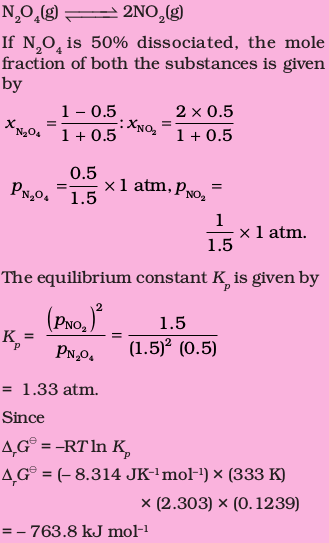
Thermodynamics deals with energy changes in chemical or physical processes and enables us to study these changes quantitatively and to make useful predictions. For these purposes, we divide the universe into the system and the surroundings. Chemical or physical processes lead to evolution or absorption of heat (q), part of which may be converted into work (w). These quantities are related through the first law of thermodynamics via ∆U = q + w. ∆U, change in internal energy, depends on initial and final states only and is a state function, whereas q and w depend on the path and are not the state functions. We follow sign conventions of q and w by giving the positive sign to these quantities when these are added to the system. We can measure the transfer of heat from one system to another which causes the change in temperature. The magnitude of rise in temperature depends on the heat capacity (C) of a substance. Therefore, heat absorbed or evolved is q = C∆T. Work can be measured by w = –pex∆V, in case of expansion of gases. Under reversible process, we can put pex = p for infinitesimal changes in the volume making wrev = – p dV. In this condition, we can use gas equation, pV = nRT.
At constant volume, w = 0, then ∆U = qV , heat transfer at constant volume. But in study of chemical reactions, we usually have constant pressure. We define another state function enthalpy. Enthalpy change, ∆H = ∆U + ∆ngRT, can be found directly from the heat changes at constant pressure, ∆H = qp.
There are varieties of enthalpy changes. Changes of phase such as melting, vaporization and sublimation usually occur at constant temperature and can be characterized by enthalpy changes which are always positive. Enthalpy of formation, combustion and other enthalpy changes can be calculated using Hess’s law. Enthalpy change for chemical reactions can be determined by

and in gaseous state by
∆rH0 = Σ bond enthalpies of the reactants – Σ bond enthalpies of the products
First law of thermodynamics does not guide us about the direction of chemical reactions i.e., what is the driving force of a chemical reaction. For isolated systems,
∆U = 0. We define another state function, S, entropy for this purpose. Entropy is a measure of disorder or randomness. For a spontaneous change, total entropy change is positive. Therefore, for an isolated system, ∆U = 0, ∆S > 0, so entropy change distinguishes a spontaneous change, while energy change does not. Entropy changes can be measured by the equation
∆S =  for a reversible process.
for a reversible process.  is independent of path.
is independent of path.
Chemical reactions are generally carried at constant pressure, so we define another state function Gibbs energy, G, which is related to entropy and enthalpy changes of the system by the equation:
∆rG = ∆rH – T ∆rS
For a spontaneous change, ∆Gsys < 0 and at equilibrium, ∆Gsys = 0.
Standard Gibbs energy change is related to equilibrium constant by
∆rG0 = – RT ln K.
K can be calculated from this equation, if we know ∆rG0 which can be found from  . Temperature is an important factor in the equation. Many reactions which are non-spontaneous at low temperature, are made spontaneous at high temperature for systems having positive entropy of reaction.
. Temperature is an important factor in the equation. Many reactions which are non-spontaneous at low temperature, are made spontaneous at high temperature for systems having positive entropy of reaction.
Q.1. Choose the correct answer. A thermodynamic state function is a quantity
(i) used to determine heat changes
(ii)whose value is independent of path
(iii)used to determine pressure-volume work
(iv) whose value depends on temperature only.
Q.2. For the process to occur under adiabatic conditions, the correct condition is:
(i) ∆T = 0
(ii) ∆p = 0
(iii) q = 0
(iv) w = 0
Q.3. The enthalpies of all elements in their standard states are:
(i) unity
(ii) zero
(iii) < 0
(iv) different for each element
Q.4. of combustion of methane is – X kJ . The value of
(i) =
(ii) >
(iii) <
(iv) = 0
NEETprep AnswerQ.5. The enthalpy of combustion of methane, graphite and dihydrogen at 298 K are, –890.3 kJ –393.5 kJ , and –285.8 kJ respectively. Enthalpy of formation of will be
(i) –74.8 kJ
(ii) –52.27 kJ
(iii) +74.8 kJ
(iv) +52.26 kJ
NEETprep AnswerQ.6. A reaction, A + B → C + D + q is found to have a positive entropy change. The reaction will be
(i) possible at high temperature
(ii) possible only at low temperature
(iii) not possible at any temperature
(iv) possible at any temperature
Q.7. In a process, 701 J of heat is absorbed by a system and 394 J of work is done by the system. What is the change in internal energy for the process?
NEETprep AnswerQ.8. The reaction of cyanamide, , with dioxygen was carried out in a bomb calorimeter, and ∆U was found to be –742.7 kJ at 298 K. Calculate enthalpy change for the reaction at 298 K.
NEETprep AnswerQ.9 Calculate the number of kJ of heat necessary to raise the temperature of 60.0 g of aluminum from 35°C to 55°C. Molar heat capacity of Al is 24 J .
NEETprep AnswerQ.10. Calculate the enthalpy change on freezing of 1.0 mol of water at 10.0°C to ice at –
10.0°C. = 6.03 kJ at 0°C.
= 75.3 J
= 36.8 J
Q.11. Enthalpy of combustion of carbon to CO2 is –393.5 kJ . Calculate the heat released upon the formation of 35.2 g of from carbon and dioxygen gas.
NEETprep AnswerQ.12. Enthalpies of formation of
are –110 kJ , – 393 kJ , 81 kJ and 9.7 kJ respectively. Find the value of for the reaction:
NEETprep AnswerQ. 13. Given
What is the standard enthalpy of formation of gas?
NEETprep AnswerQ.14. Calculate the standard enthalpy of formation of from the following data:
NEETprep AnswerQ.15. Calculate the enthalpy change for the process
and calculate bond enthalpy of C-Cl in .
NEETprep AnswerQ.16. For an isolated system, ∆U = 0, what will be ∆S?
NEETprep AnswerQ.17. For the reaction at 298 K,
2A + B → C
∆H = 400 kJ and ∆S = 0.2 kJ
At what temperature will the reaction become spontaneous considering ∆H and ∆S to be constant over the temperature range?
Q.18. For the reaction,
, what are the signs of ∆H and ∆S?
NEETprep AnswerQ. 19. For the reaction
Calculate for the reaction, and predict whether the reaction may occur spontaneously.
NEETprep AnswerQ.20. The equilibrium constant for a reaction is 10. What will be the value of ?
NEETprep AnswerQ.21. Comment on the thermodynamic stability of , given
NEETprep AnswerQ.22. Calculate the entropy change in surroundings when 1.00 mol of is formed under standard conditions. .
NEETprep AnswerEXEMPLAR
1. Thermodynamics is not concerned about
(a) energy changes involved in a chemical reaction
(b) the extent to which a chemical reaction proceeds
(c) the rate at which a reaction proceeds
(d) the feasibility of chemical reaction
NEETprep Answer2. Which of the following statement is correct?
(a) The presence of reacting species in a covered beaker is an example of open system.
(b) There is an exchange of energy as well as matter between the system and the surroundings in a closed system.
(c) The presence of reactants in a closed vessel made up of copper is an example of a closed system.
(d) The presence of reactants in a thermos flask or any other closed insulated vessel is an example of a closed system.
NEETprep Answer3. The state of a gas can be described by quoting the relationship between
(a) pressure, volume, temperature
(b) temperature, amount, pressure
(c) amount, volume, temperature
(d) pressure, volume, temperature, amount
NEETprep Answer4. The volume of gas is reduced to half from its original volume. The specific heat will be
(a) reduce to half
(b) be doubled
(c) remain constant
(d) increase four times
NEETprep Answer5. During complete combustion of one mole of butane, 2658 kJ of heat is released. The thermochemical reaction for above change is
(a)
(b)
(c)
(d)
NEETprep Answer6. of formation of at certain temperature is . The value of is
(a) zero
(b)
(c)
(d) equal to
NEETprep Answer7. In an adiabatic process, no transfer of heat takes place between system and surroundings. Choose the correct option for free expansion of an ideal gas under adiabatic condition from the following.
(a)
(b)
(c)
(d)
NEETprep Answer8. The pressure-volume work for an ideal gas can be calculated by using the expression . The work can also be calculated from the pV-plot by using the area under the curve within the specified limits. When an ideal gas is compressed (a) reversibly or (b) irreversibly from volume to . Choose the correct option.
(a)
(b)
(c)
(d)
NEETprep Answer9. The entropy change can be calculated by using the expression . When water freezes in a glass beaker, choose the correct statement amongs the following.
(a) (system) decreases but (surroundings) remains the same
(b) (system) increases but (surroundings) decreases
(c) (system) decreases but (surroundings) increases
(d) (system) decreases but (surroundings) also decreases
NEETprep Answer10. On the basis of theromochemical equations (1), (2) and (3), find out which of the algebraic relationships given in options (a) to (d) is correct
1.
2.
3.
(a) z=x+y
(b) x=y-z
(c) x=y+z
(d) y=2z-x
NEETprep Answer11. Consider the reactions given below. On the basis of these reactions find out which of the algebraic relationship given in options (a) to (d) is correct?
1.
2.
(a) x=y
(b) x=2y
(c) x>y
(d) x
12. The enthalpies of elements in their standard states are taken as zero. The enthalpy of formation of a compound
(a) is always negative
(b) is always positive
(c) may be positive or negative
(d) is never negative
NEETprep Answer13. Enthalpy of sublimation of a substance is equal to
(a) enthalpy of fusion + enthalpy of vaporisation
(b) enthalpy of fusion
(c) enthalpy of vaporisation
(d) twice the enthalpy of vaporisation
NEETprep Answer14. Which of the following is not correct?
(a) is zero for a reversible reaction.
(b) is positive for a spontaneous reaction.
(c) is negative for a spontaneous reaction.
(d) is positive for a non-spontaneous reaction.
NEETprep Answer15. Thermodynamics mainly deals with
(a) interrelation of various forms of energy and their transformation from one form to another.
(b) energy changes in the processes which depend only on initial and final states of the microscopic systems containing a few molecules.
(c) how and at what rate these energy transformations are carried out.
(d) the system in equilibrium state or moving from one equilibrium state to another equilibrium state.
NEETprep Answer16. In an exothermic reaction, heat is evolved, and system loses heat to the surrounding. For such system
(a) qp will be negative
(b) will be negative
(c) qp will be positive
(d) wil be positive
NEETprep Answer17. The spontaneity means, having the potential to proceed without the assistance of external agency. The processes which occur spontaneously are
(a) flow of heat from colder to warmer body
(b) gas in a container contracting into one corner
(c) gas expanding to fill the available volume
(d) buring carbon in oxygen to give carbon dioxide
NEETprep Answer18. For an ideal gas, the work of reversible expansion under isothermal condition can be calculated by using the expression . A sample containing 1.0 mol of an ideal gas is expanded isothermally and reversible to ten times of its original volume, in to separate experiments. The expansion is carried out at 300 K and at 600 K respectively. Choose the correct option.
(a) Work done at 600 K is 20 times the work done at 300 K
(b) Work done at 300 K is twice the work done at 600 K
(c) Work done at 600 K is twice the work done at 300 K
(d) in both cases
NEETprep Answer19. Consider the following reaction between zinc and oxygen and choose the correct options but out of the options given below
(a) The enthalpy of two moles of ZnO is less than the total enthalpy of two moles of Zn and one mole of oxygen by 693.8 kJ
(b) The enthalpy of two moles of ZnO is more than the total enthalpy of two moles of Zn and one mole of oxygen by 693.8 kJ
(c) energy is evolved in the reaction
(d) energy is absorbed in the reaction
NEETprep Answer20. 18.0 g of water completely vaporises at and 1 bar pressure and the enthalpy change in the process is . What will be the enthalpy change for vaporising two moles of water under the same conditions? What is the standard enthalpy of vaporisation for water?
NEETprep Answer21. One mole of acetone requires less heat to vaporise than 1 mole of water. Which of the two liquids has higher enthalpy of vaporisation?
NEETprep Answer22. Standard molar enthalpy of formation, is just a special case of enthalpy of reaction, . Is the for the following reaction same as ? Give reason for your answer.
NEETprep Answer23. The value of for is . Calculate enthalpy change for the following reaction.
NEETprep Answer24. Enthalpy is an extensive property. In general, if enthalpy of an overall reaction AB along one route is and represent enthalpies of intermediate reactions leading to product B. What will be the relation between overall reaction and etc for intermediate reactions.
NEETprep Answer25. The enthalpy of atomisation for the reaction . What is the bond energy of C-H bond?
NEETprep Answer26. Use the following data to calculate for NaBr. for sodium metal, ionisation enthalpy of sodium, electron gain enthalpy of bromine, bond dissociation enthalpy of bromine, for NaBr(s)
NEETprep Answer27. Given that for mixing of two gases. Explain whether the diffusion of these gases into each other in a closed container is a spontaneous process or not?
NEETprep Answer28. Heat has randomising influence on a system and temperature is the measure of average chaotic motion of particles in the system. Write the mathematical relation which relates these three parameters.
NEETprep Answer29. Increase in enthalpy of the surroundings is equal to decrease in enthalpy of the system. Will the temperature of system and surroundings be the same when they are in thermal equilibrium?
NEETprep Answer30. At 298 K, Kp for reaction is 0.98. Predict whether the reaction is not spontaneous or not.
NEETprep Answer31. A sample of 1.0 mol of a monoatomic ideal gas is taken through a cyclic process of expansion and compression as shown in figure. What will be the value of for the cycle as a whole?

32. The standard molar entropy of is . Will the standard molar entropy of be more, or less than ?
NEETprep Answer33. Identify the state functions and path functions out of the following:
enthalpy, entropy, heat, temperature, work, free energy.
NEETprep Answer34. The molar enthalpy of vaporisation of acetone is less than that of water. Why?
NEETprep Answer35. Which quantity out of and will be zero at equilibrium?
NEETprep Answer36. Predict the change in internal energy for an isolated system at constant volume.
NEETprep Answer37. Although heat is a path function but heat absorbed by the system under certain specific conditions is independent of path. What are those conditions? Explain.
NEETprep Answer38. Expansion of a gas in vacuum is called free expansion. Calculate the work done and the change in internal energy when 1L of ideal gas expands isothermally into vacuum until its total volume is 5L?
NEETprep Answer39. Heat capacity (Cp) is an extensive property but specific heat (c) is intensive property. What will be the relation between Cp and c for 1 mole of water?
NEETprep Answer40. The difference between Cp and Cv can be derived using the empirical relation H=U+pV. Calculate the difference between Cp and Cv for 10 moles of an ideal gas.
NEETprep Answer41. If the combustion of 1g of graphite produces 20.7 kJ of heat, what will be molar enthalpy change? Give the significance of sign also.
NEETprep Answer42. The net enthalpy change of a reaction is the amount of energy required to break all the bonds in reactant molecules minus amount of energy required to form all the bonds in the product molecules. What will be the enthalpy change for the following reaction? . Given that, bond energy of is , and respectively.
NEETprep Answer43. The enthalpy of vaporisation of is . Calculate the heat required for the vaporisation of 284 g of at constant pressure.
(Molar mass of )
44. The enthalpy of reaction for the reaction
What will be standard enthalpy of formation of ?
NEETprep Answer45. What will be the work done on an ideal gas enclosed in a cylinder, when it is compressed by a constant external pressure, pext in a single step as shown in figure? Explain graphically.
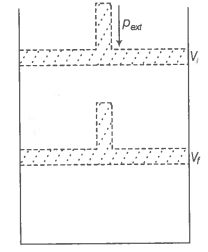
46. How will you calculate work done on an ideal gas in a compression, when change in pressure is carried out in infinite steps?
NEETprep Answer47. Represent the potential energy/enthalpy change in the following processes graphically.
(a) Throwing a stone from the ground to roof.
(b)
In which of the processes potential energy/enthalpy change is contributing factor to the spontaneity?
NEETprep Answer48. Enthalpy diagram for a particular reaction is given in figure. Is it possible to decide spontaneity of a reaction from given diagram. Explain.
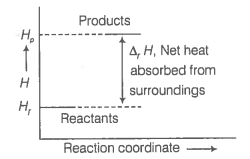
49. 1.0 mol of monoatomic ideal gas is expanded from state (1) to state (2) as shown in figure. Calculate the work done for the expansion of gas from state (1) to state (2) at 298 K.

50. An ideal gas is allowed to expand against a constant pressure of 2 bar from 10 L to 50 L in one step. Calculate the amount of work done by the gas. If the same expansion were carried out reversibly, will the work done be higher or lower than the earlier case?
(Given that, 1 L bar=100 J)
NEETprep Answer51. Match the following.
List II |
List II |
A. Adiabatic process |
1. Heat |
B. Isolated system |
2. At constant volume |
C. Isothermal change |
3. First law of thermodynamics |
D. Path function |
4. No exchange of energy and matter |
E. State function |
5. No transfer of heat |
F. |
6. Constant temperature |
G. Law of conservation of energy |
7. Internal energy |
H. Reversible process |
8. Pext = 0 |
I. Free expansion |
9. At constant pressure |
J. |
10. Infinitely slow process which proceeds through a series of equilibrium states. |
K. Intensive property |
11. Entropy |
L. Extensive property |
12. Pressure |
|
13. Specific heat |
52. Match the following process process with entopy change
Reaction |
Entropy change |
A. A liquid vaporizes |
1. |
B. Reaction is non-spontaneous at all temperatures and is positive |
2. |
C. Reversible expansion of an ideal gas |
3. |
53. Match the following parameters with description for spontaneity.
Description |
|
A. + - + |
1. Non-spontaneous at high temperature |
B. - - + at high T |
2. Spontaneous at all temperatures |
C. - + - |
3. Non-spontaneous at all temperatures |
54. Match the following
A. Entropy of vaporization |
1. decreases |
B. K for spontaneous process |
2. is always positive |
C. Crystalline solid state |
3. lowest entropy |
D. in adiabatic expansion of ideal gas |
4. |
55. Assertion (A) Combustion of all organic compounds is an exothermic reaction.
Reason (R) The enthalpies of all elements in their standard state are zero.
(a) Both A and R are true and R is the correct explanation of A
(b) Both A and R are true but R is not the correct explanation of A
(c) A is true but R is false
(d) A is false but R is true
NEETprep Answer56. Assertion (A) Spontaneous process is an irreversible process and may be reversed by some external agency.
Reason (R) Decrease in enthalpy is a contributing factor for spontaneity.
(a) Both A and R are true and R is the correct explanation of A
(b) Both A and R are true but R is not the correct explanation of A
(c) A is true but R is false
(d) A is false but R is true
NEETprep Answer57. Assertion (A) A liquid crystallises into a solid and is accompanied by decrease in entropy.
Reason (R) In crystals, molecules organise in an ordered manner.
(a) Both A and R are true and R is the correct explanation of A
(b) Both A and R are true but R is not the correct explanation of A
(c) A is true but R is false
(d) A is false but R is true
NEETprep Answer58. Derive the relationship between and for an ideal gas. Explain each term involved in the equation.
NEETprep Answer59. Extensive properties depend on the quantity of matter but intensive properties do not. Explain whether the following properties are extensive or intensive.
Mass, internal energy, pressure, heat capacity, molar heat capacity, density, mole fraction, specific heat, temperature and molarity.
NEETprep Answer60 The lattice enthalpy of an ionic compound is the enthalpy when one mole of an ionic compound present in its gaseous state, dissociates into its ions. It is impossible to determine it directly by experiment. Suggest and explain an indirect method to measure lattice enthalpy of NaCl(s).
NEETprep Answer61. is energy available to do useful work and is thus a measure of "Free energy". Show mathematically that is a measure of free energy. Find the unit of . If a reaction has positive enthalpy change and positive entropy change, under what condition will the reaction be spontaneous?
NEETprep Answer62. Graphically show the total work done in an expansion when the state of an ideal gas is changed reversibly and isothermally from to . With the help of a pV plot compare the work done in the above case with that carried out against a constant pressure .
NEETprep Answer